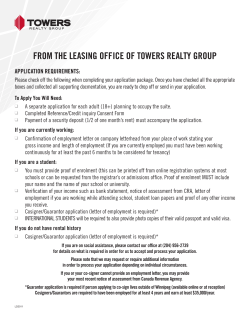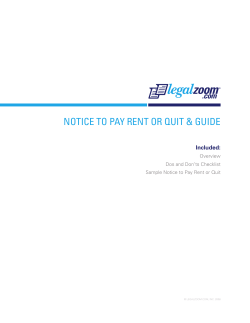
I
AND 88 8 SER V H NC THE BE ING 1 BA R SINCE www. NYLJ.com MOnday, July 2, 2012 Volume 248—NO. 1 Expert Analysis Outside Counsel When Letters of Intent For Commercial Leases Are Binding I t is customary for parties who are negotiating a commercial real estate lease to set forth terms of a potential lease agreement in a non-binding letter of intent (LOI). However, when a broker or lawyer prepares an LOI that includes material terms, and fails to include specific language reserving the parties’ right to walk away from a deal, the LOI may be enforceable. In this article, we define the term “letter of intent” with respect to a commercial lease, set forth the general law as to when terms within LOIs are, and are not, binding, and present decisions on their enforceability to provide guidance to drafters of these documents. LOIs are, when drafted correctly, non-binding documents that outline the key terms to a business deal. They are utilized with respect to acquisitions, loans and commercial real estate leases, among other types of transactions. An LOI with respect to a lease is a letter between a landlord and tenant, which may or may not be executed, that sets forth the fundamental points for a potential agreement of lease.1 The issue of whether or not terms within an LOI are binding is a question of contract law. As with any contract enforceability issue, the analysis begins with a review of the plain language of the document. If the plain language of an LOI manifests an intention by the parties to obligate themselves to the document’s terms, it will be a binding contract. The Court of Appeals has found that this rule is especially important in the context of real property transactions, where commercial certainty is a paramount concern.2 The relevant decisions concern documents referred to as, among other things, “memorandums of understanding” and “term sheets,” as well as LOIs, and tend to address two distinct issues: (1) whether the subject document is a mere “agreement to agree,” which is not a binding agreement; and (2) whether the document is non-binding because it contains language that specifically reserves the parties’ right to pull out of the lease negotiation before it executes a formal lease agreement (“non-binding language”). Not surprisingly, some of these decisions contain analysis that overlaps these two issues. Jack Malley is a partner at Smith Buss & Jacobs, and is a member of the firm’s litigation and real estate departments. By Jack Malley Agreements to Agree An agreement that leaves material terms open for future negotiation is generally an unenforceable agreement to agree. 3 Agreements that lack material terms can be enforceable, however, if they provide a methodology for determining the material terms.4 The decisions construing whether an agreement contains sufficient material terms provide guidance as to what terms are considered “material” with respect to a commercial lease. If the necessary non-binding language is not included in the LOI, a party may be bound by an agreement that it believed was a mere agreement to agree. For example, in the recently decided Female Academy of the Sacred Heart v. Doane Stuart School, the Appellate Division, Third Department, found that a “memorandum of understanding” was an unenforceable agreement to agree because it “failed to specify several material terms of the future lease, including the amount of rent to be paid, when the lease was to take effect and what portion of the property would be leased.”5 In St. Regis Paper v. Rayward, the Appellate Division, First Department, held that a “memorandum agreement” concerning a lease between parties was not binding because it lacked any “material particulars,” including the beginning of the lease term and the date when the rent was to be paid.6 In Uniland Partnership of Delaware v. Blue Cross of Western New York, the Appellate Division, Fourth Department, held that a letter agreement that provided that the parties would enter into a lease was not binding because, among other things, it did not identify the area to be leased or the duration of the lease.7 In addition, the application of the Statute of Frauds can determine whether or not an LOI is binding. Under the Statute of Frauds, GOL §5-703(2), any lease agreement for more than one year is void unless it is in writing, sets forth the consideration to be paid, and is executed by the party to be charged. In Rouzani v. Rapp, the Appellate Division, Second Department, held that in order to satisfy the Statute of Frauds, the subject writing must state the parties’ agreement “with such certainty that the substance thereof will appear from the writing alone.”8 Applying this rule, the court found that the subject agreement failed to satisfy the Statute of Frauds because there was an understanding that a more formal contract was to follow, and that essential terms had been left for future negotiation including the lease commencement date, a definite term, the identity of the parties and the rent for the entire term. Non-Binding Language The New York courts have identified certain terms that indicate that a preliminary agreement, such as one labeled as an LOI, is not binding, including where the agreement contains open terms; calls for future approval, and expressively anticipates future preparation and execution of contract documents9; provides that the subject offer could be withdrawn at any time before an ultimate agreement is reached10; and provides that it is “not binding.”11 In 2004 McDonald Realty v. 2004 McDonald Avenue Corp., the Second Department applied these types of terms to find that an LOI was not binding.12 In that case, a tenant brought an action for specific performance of an LOI. The fully executed LOI set forth binding terms outlining the prospective tenant’s due diligence concerning the potential deal, but expressly stated that: “[t]his Letter is not a binding agreement except to the extent specifically stated below.” The LOI further stated that it set forth the basic terms of a “proposed” lease; that the “Tenant’s attorney shall…prepare…a Lease Agreement”; and that “[i]n the event that no Lease Agreement is executed…this Letter shall be of no effect except as specifically set forth herein.” Based on these facts, the Appellate Division affirmed the Supreme Court’s decision granting the landlord’s motion to dismiss the tenant’s action. The court held that “[w]here as here, an LOI regarding a lease for commercial property contained open MOnday, July 2, 2012 terms, called for future approval, and expressly anticipated the future preparation and execution of contract documents, the Supreme Court properly determined that it was not binding.”13 In Inside Swing v. Le Chase, the Fourth Department held that the parties did not enter into a binding lease by the execution of an LOI because the LOI “leaves several material terms for future negotiations and expressly provides that it is ‘not binding’ and ‘preliminary to the negotiation of a Lease Agreement.’”14 The court further held that the LOI was not binding because it “merely expressed their ‘intent to negotiate the essential terms of a binding agreement.’”15 In Benedict Realty v. City of New York, the Supreme Court, Richmond County, found that an LOI from the City of New York, Department of Citywide Administrative Services, to its landlord concerning a new lease between the parties was not binding because the “‘letter of intent’ specified that the lease was enclosed for the plaintiff’s review, and that the offer could be withdrawn at any time prior to the approval of the appropriate agencies.”16 When LOI Is Found Binding The decision in Demmert Building v. AMP,17 also provides guidance as to when courts will find that an LOI is binding. In Demmert, the LOI specified the square footage, the lease term, the rent, and the date the tenant was to take possession. Further, the LOI provided that the landlord would perform a build-out of the tenant’s space, and that the tenant would pay for the cost of the build-out over and above a base amount to be paid by the landlord. The landlord and tenant subsequently entered into a lease that was silent as to which party was responsible for paying for the build-out. The tenant took the position that the LOI was not a binding contract and did not obligate it to pay any portion of the build out. The U.S. District Court for the Eastern District of New York disagreed and held that the portion of the LOI that required the tenant to pay for the build-out was binding because the lease was silent on the issue, and the LOI included a specific method for allocating the cost of the build-out, and a term granting the landlord the right to approve a floor plan. In addition, the partial performance of the LOI weighed in favor of finding that it was binding. Specifically, the landlord permitted the tenant to modify the plans for the build-out, and the tenant requested and obtained changes to the build-out plans.18 Although the court in Bed, Bath & Beyond v. Ibex Construction19 construed an LOI concerning a construction contract, it is highly instructive as to the enforceability of lease LOIs. In that case, the First Department found that the LOI was binding because it set forth the price, scope of work to be performed, and time for performance, and did not contain a reservation that either party could be bound unless a formal lease was signed. Further, the court held that the contractor’s initial performance, without the parties’ agreement to a formal construction agreement, indicated the contractor’s intent to be bound by the LOI. In reaching this decision, the Bed, Bath & Beyond court emphasized that a substance over form analysis should be applied to determine whether an LOI is binding. As such, the parties’ denomination of the subject writing as a “letter of intent,” and a provision calling for a more formal agreement, did not render the LOI unenforceable. Types of Agreement Finally, there is a line of decisions in the U.S. Court of Appeals for the Second Circuit and the New York district courts that set forth a more systematic approach for determining whether a “preliminary agreement” is binding, which derive from the Southern District’s 1987 decision in Teachers Ins. and Annuity Assoc. of America v. Tribune. 20 Under Tribune and its progeny, two distinct types of preliminary agreements are identified. By the first type of agreement, the parties have agreed on all the terms that require negotiation, but have not formalized their agreement.21 By the second type of agreement, the parties have agreed to some major terms, but others must still be negotiated.22 Under the Tribune decision, the first type of preliminary agreement “binds both sides to their ultimate contractual objective in recognition that the contract has been reached, despite the anticipation of further formalities.”23 In contrast, the Tribune court found that the second type of agreement “does not commit the parties to their ultimate contractual objective but rather to the obligation to negotiate the open issues in good faith in an attempt to reach the ultimate objective within the agreed framework.”24 With respect to the second type of agreement, the federal courts consider the following as to whether the parties intended to be bound by the preliminary agreement: “(1) the language of the agreement; (2) the content of the negotiations; (3) the existence of open terms; (4) partial performance; and (5) the necessity of putting the agreement in final form, as indicated by the customary form of such transactions.”25 While this type of analysis, identifying preliminary agreements as two separate types, carries weight in federal court, the Court of Appeals has found that the categorizing of preliminary agreements in that way is a rigid classification that is not useful.26 716, 859, N.Y.S.2d 209, 211 (2d Dept. 2008). 4. Carmon v. Soleh Boneh, 206 A.D.2d 450, 614 N.Y.S.2d 555, 556 (2d Dept. 1994). 5. Female Academy of the Sacred Heart v. Doane Stewart School, 91 A.D.3d 1254, 1255-56, 937 N.Y.S.2d 682, 685 (3d Dept. 2012). 6. St. Regis Paper v. Rayward, 16 A.D.2d 130, 133, 225 N.Y.S.2d 871, 873 (1st Dept. 1962). 7. Uniland Partnership of Delaware v. Blue Cross of Western New York, 27 A.D.3d 1131, 1132, 811 N.Y.S.2d 517, 518 (2d Dept. 2006). 8. Rouzani v. Rapp, 203 A.D.2d 446, 447, 610 N.Y.S.2d 600, 601 (2d Dept. 1994). 9. Carmon, 206 A.D.2d 450, 614 N.Y.S.2d at 556. 10. Benedict Realty v. City of New York, No. 10784/03, 11 Misc.3d 1086(A), 819 N.Y.S.2d 846, 2006 WL 1094590, at *4 (Supreme Court, Richmond County April 24, 2006). 11. Inside Swing v. Le Chase, 236 A.D.2d 884, 653 N.Y.S.2d 474, 475 (4th Dept. 1997). 12. 2004 McDonald Realty v. 2004 McDonald Avenue Corp., 50 A.D.3d 1021, 858 N.Y.S.2d 203 (2d Dept. 2008). 13. 2004 McDonald Realty, 50 A.D.3d at 1022, 858 N.Y.S.2d at 205. 14. Inside Swing, 236 A.D.2d 884, 653 N.Y.S.2d at 475. 15. Inside Swing, 236 A.D.2d 884, 653 N.Y.S.2d at 475 (citation omitted). 16. Benedict Realty, 11 Misc.2d 1086(A), 819 N.Y.S.2d 846, 2006 WL 1094590 at *4. 17. Demmert Building v. AMP, Nos. 806-70942-478, 807-8100478, 2008 WL 516679 (E.D.N.Y Feb. 25, 2008). 18. Demmert, 2008 WL 516679 at *6-7. 19. Bed, Bath & Beyond v. Ibex Construction, 52 A.D.3d 413, 860 N.Y.S.2d 107 (1st Dept. 2008). 20. Teachers Ins. and Annuity Assoc. of America v Tribune, 670 F.Supp. 491 (S.D.N.Y. 1987). 21. Arcadian Phosphates v. Arcadian, 884 F.2d 69, 72 (2d Cir. 1989). 22. Arcadian, 884 F.2d at 72. 23. Tribune, 670 F.Supp. at 498. 24. Tribune, 670 F.Supp. at 498. 25. Arcadian, 884 F.2d at 7.. 26. IDT v. Tyco Group, 13 N.Y.3d 209, 213 n. 2, 918 N.E.2d 913, 890 N.Y.S.2d 401 (2009). Drafting So what can drafters of LOIs concerning commercial leases take from all of these decisions? The main conclusion that should be drawn is that if the drafter truly intends the LOI to be a non-binding agreement, he or she must include thorough and clear non-binding language, such as that set forth above. This is critical because the typical LOI drafted by sophisticated parties contains material lease terms, such as the amount of rent, the lease term, the rent commencement date and a description of the premises. If the necessary non-binding language is not included in the LOI, a party may be bound by an agreement that it believed was a mere agreement to agree to its detriment. •••••••••••••••• ••••••••••••• 1. Commercial Real Estate Leasing §1.8 (2d ed). 2. W.W.W. Associates v. Giancontieri, 77 N.Y.2d 157, 162, 566 N.E.2d 639, 642, 565 N.Y.S.2d 440, 443 (1990). 3. 410 BFR v. Chmelecki Asset Management, 51 A.D.3d 715, Reprinted with permission from the July 2, 2012 edition of the NEW YORK LAW JOURNAL © 2012 ALM Media Properties, LLC. All rights reserved. Further duplication without permission is prohibited. For information, contact 877-257-3382 or reprints@alm. com. # 070-07-12-06
© Copyright 2025














![Sample Letter: Request for Deposit Return [Date] [Landlord/Manager’s Address]](http://cdn1.abcdocz.com/store/data/000031946_2-a5dff79aaa9f3543944111c0539def82-250x500.png)



